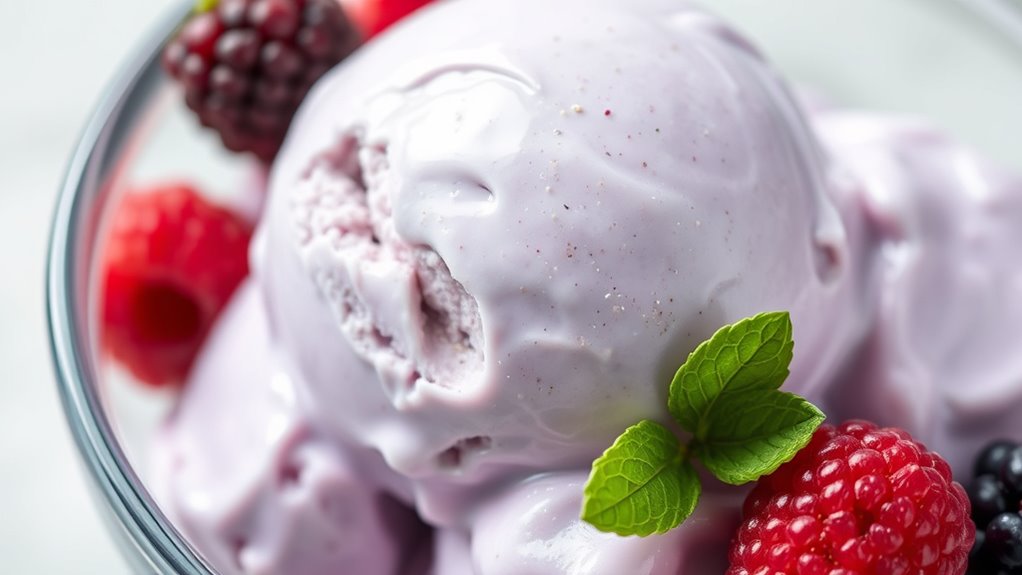Adding whey or plant proteins to your ice cream boosts its nutritional value, allowing you to enjoy a delicious treat while increasing your protein intake. Whey provides a mild sweetness, enriching the flavor, while plant proteins like pea or rice add depth and cater to dietary preferences. Proper blending creates a smooth, creamy texture that rivals traditional ice cream, helping you meet health goals without sacrificing flavor—exploring further reveals how to perfect your protein-rich frozen dessert.
Key Takeaways
- Incorporate whey or plant protein powders into ice cream recipes to boost nutritional value and enhance flavor.
- Proper blending ensures a smooth, creamy texture comparable to traditional ice cream.
- Whey protein adds a mild sweetness, while plant proteins offer depth and complexity to taste.
- Using proteins can stabilize the dessert’s structure and promote longer-lasting satiety.
- Protein-enriched ice cream supports health goals by reducing sugar spikes and increasing daily protein intake.

Protein-enriched ice cream is gaining popularity as a delicious way to boost your daily protein intake without sacrificing flavor. If you’re looking for a treat that not only satisfies your sweet tooth but also offers nutritional benefits, this innovative dessert is worth exploring. By adding whey or plant-based proteins, you can turn a simple ice cream into a powerhouse of nutrients. These proteins provide essential amino acids that support muscle recovery, boost your immune system, and keep you feeling full longer. Incorporating protein into your favorite frozen treat makes it easier to meet your daily nutritional goals, especially if you struggle to get enough protein from traditional sources.
One of the biggest advantages of protein-enriched ice cream is its flavor enhancement. Unlike some health-focused foods that compromise taste, adding whey or plant proteins can actually elevate the overall flavor profile. Whey protein, for instance, tends to have a mild, slightly sweet flavor that blends seamlessly into creamy bases, enhancing richness without overpowering the original taste. Plant proteins, such as pea or rice protein, might have a more neutral or earthy flavor, but when carefully incorporated, they add depth and complexity to your ice cream. Many recipes utilize natural flavorings like vanilla, cocoa, or fruit purees to mask any potential bitterness from the proteins, resulting in a dessert that’s both nutritious and indulgent.
You also have flexibility in how you incorporate these proteins. Whey protein powders are widely available and easy to mix into homemade recipes, giving you control over the sweetness and texture. Plant proteins, being plant-based, cater to vegans and those with dairy sensitivities, broadening the appeal of your frozen creation. When blended properly, these proteins create a smooth, creamy consistency that rivals traditional ice cream, making it a satisfying snack or dessert after a workout or a long day. Additionally, the added protein can help stabilize blood sugar levels, preventing spikes and crashes that often follow high-sugar treats.
Frequently Asked Questions
How Does Protein Enrichment Affect Ice Cream Texture?
Adding protein enrichment to ice cream affects its texture by causing modification and altering the mouthfeel. You might notice it becomes creamier or denser, depending on the type and amount of protein used. Protein can also influence how smooth or gritty the ice cream feels, enhancing the overall sensory experience. By adjusting the protein level, you can tailor the texture to achieve the desired balance of creaminess and mouthfeel enhancement.
Are Whey and Plant Proteins Equally Effective in Ice Cream?
Whey and plant proteins both work well in ice cream, but they differ in absorption and allergen considerations. Whey protein absorbs quickly, making it ideal for a smooth texture, but it may cause allergies for some. Plant proteins, like pea or rice, absorb more slowly and are hypoallergenic, appealing to sensitive consumers. Your choice depends on your target audience’s dietary needs and preferences, ensuring ideal protein intake and allergen safety.
Can Protein-Enriched Ice Cream Replace Meal Replacements?
You probably shouldn’t rely on protein-enriched ice cream as a meal replacement, as it offers limited nutritional benefits. While it provides a tasty way to boost protein intake—up to 15 grams per serving—and enhances flavor, it lacks essential nutrients like fiber, carbs, and healthy fats needed for a balanced meal. For proper nutrition, stick to complete meals instead of using ice cream as a substitute.
What Are the Best Flavor Pairings for Protein Ice Cream?
You’ll love flavor pairings like berry and banana, or mango with coconut, which create delicious fruit combinations. For spice pairings, try cinnamon with apple or nutmeg with pumpkin for a warm, cozy taste. Combining these fruits and spices enhances the flavor of your protein ice cream, making it more enjoyable. Experiment with different mixes to find your perfect match, and enjoy a tasty, nutritious treat anytime.
How Long Does Protein-Enriched Ice Cream Stay Fresh?
You should consume protein-enriched ice cream within 1 to 2 months if stored properly in the freezer. Proper storage stability helps prevent microbial growth, which can spoil the ice cream faster. Always keep it tightly sealed and at a consistent freezing temperature. If you notice any off smells, changes in texture, or ice crystals, discard it to avoid health risks. Proper storage extends freshness and safety.
Conclusion
Imagine scooping your favorite protein-enriched ice cream on a sunny afternoon, the creamy texture blending perfectly with a splash of fresh fruit. As you enjoy the rich flavor, you realize that adding whey or plant proteins not only boosts your nutrition but also makes your treat more satisfying. Coincidentally, this indulgence becomes a small step toward healthier choices, turning a simple dessert into a delicious way to fuel your body—proving that good taste and wellness can melt together perfectly.










